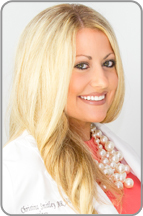Christina Smitley, FNP-C with Advanced Dermatology PC, Shares Tips on Controlling Excess Skin Oil
ALBERTSON, N.Y. (PRWEB) April 06, 2020
The number-one essential skin oil? Sebum. With no boutique purchase needed, because it’s self-produced, released by our pores to coat and protect. “In the long run,” notes Christina Smitley, a board-certified family nurse practitioner who specializes in dermatology with Advanced Dermatology PC, “people with ‘oily’ skin typically have ‘younger’ skin and develop fewer wrinkles. That said, many are understandably challenged by how to manage its shiny appearance. And, uncontrolled, oily skin can contribute to acne, this country’s most common skin problem.”
Sebaceous glands connect to our skin’s pores and play a key maintenance role, producing sebum to keep our skin healthy and ward off dryness.
“There are a number of factors that can put sebum production into overdrive,” explains Smitley, “including hormones, stress, diet, environment, and genes. Left untreated, excess sebum can contribute to clogged pores, triggering pimples. Balancing our skin’s oil can help lessen the likelihood of a breakout.”
Recent research has shone a light on the interplay between stress and diet and the activity of the sebaceous gland. “We’re also learning more about different approaches for moderating oil production,” observes Smitley, “as well as what to avoid.”
With that in mind, she offers the following suggestions:
6 Tips on Controlling Excess Skin Oil:
- Say no to scrubbing! “We can’t wash the oil away,” emphasizes Smitley. “In fact, overwashing triggers our skin to produce even more sebum. It’s best to use gentle, non-soap cleansers and warm (not hot!) water, in limited doses: only twice a day and when sweaty. Gently use your fingers to wash, and then pat dry – no rubbing.”
- Exfoliating? Mind the mantle! “Careful exfoliating,” observes Smitley, “can prevent sebum from clogging pores. Chemical-based exfoliants, such as glycolic or lactic acid, are typically more gentle than mechanical exfoliants, like brushes and scrubs. But, as with cleansing, we don’t want to overdo it: For oily skin, at most, three times a week. And follow-on moisturizing is essential.”
- Moisturizing is a must! “Yes,” states Smitley, “oily skin needs moisturizing too. Moisturizing helps prevent dryness that triggers sebum. The key is to use an oil-free, ‘non-comedogenic’ product that won’t clog pores. Those with hyaluronic acid can help maintain hydration. Also, timing counts: Moisturize ASAP after cleansing, optimally within a minute and no more than three minutes after drying, to lock in your skin’s moisture.”
- Help your sebaceous glands relax: “Stress and food choices,” explains Smitley, “can put our sebaceous glands into overdrive. When we’re stressed, we produce more of the hormones that turn on our sebum production. Likewise, foods that quickly break down into sugar trigger sebum. Sugar spikes are the result of more than dessert: white rice, pasta, potatoes, and bread all quickly break down to glucose. Moderation with these high-glycemic foods can help keep our sebaceous glands in balance.”
- Products? The bad – and the good: “Yes, our skin care products should be oil-free and non-comedogenic, as well as free from drying agents like alcohol,” notes Smitley. “But we also want to take care that other products, like hair care and cosmetics, aren’t introducing oils or irritants. In terms of what can help, gentle use of blotting paper (no rubbing!) can remove excess oil. And more recent research suggests that topical formulations with L-carnitine or green tea can limit the production of sebum.”
- Still frustrated? See an expert: “If home treatments aren’t enough,” says Smitley, “the dermatologist’s office offers a wide range of interventions. Building a relationship with your skin specialist can also provide access to new techniques. For example, we’re seeing research that shows that ‘botox’ treatments hold promise for controlling oily skin.”
“Oily skin,” concludes Smitley, “can be balanced so that our skin maintains the protection it needs and individuals have the control that they want.”
Bio: Christina Smitley, FNP-C, is a family nurse practitioner with Advanced Dermatology pc, is board-certified through the American Academy of Nurse Practitioners.
Advanced Dermatology P.C.and the Center for Laser and Cosmetic Surgery (New York & New Jersey) is one of the leading dermatology centers in the nation, offering highly experienced physicians in the fields of cosmetic and laser dermatology as well as plastic surgery and state-of-the-art medical technologies. http://www.advanceddermatologypc.com

